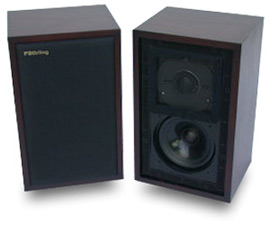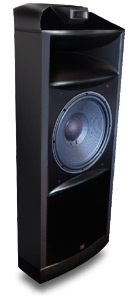 |
| December 15, 2002 Sound and Music: Two-Way Loudspeakers Last month’s speaker feature examined how a drive unit works. We took a close-up look at the Lowther brand from the UK, makers of probably the oldest driver type still in current production. This driver is unusual for several reasons. It’s specifically designed for horn loading and has extraordinarily high efficiency; both traits were very useful in the days of low-powered valve amps. But it’s also designed to operate full range, that is, covering the entire audio bandwidth with just a single drive unit. Lowther isn’t the only company to pursue the full-range single-driver approach -- brands such as Jordan and Bandor (UK), Rehdeko (France), and Eclipse (Japan) all adopt different variations on the same strategy. But they’re very much the exceptions in the whole scheme of things. Feeding the entire audio signal through a single voice coil has an obvious advantage in ensuring the overall coherence of the musical signal. But the single-driver approach has some very obvious limitations. It always experiences minor problems at the extreme top and bottom of the audio band -- the deep bass and top-end air -- and often struggles with power handling and/or loudness capabilities too. There’s some truth in the observation that single, full-range drivers work very well indeed for headphones, where they’re tightly coupled to the ears and don’t have to work too hard, but have trouble when asked to fill a normal-sized room. The other difficulty for the single-driver system involves the way it distributes or disperses the sound. When the cone is smaller than the wavelength, the sound waves spread out in all directions from the source, a bit like the way light spreads out from a light bulb. However, when the cone is larger than the wavelength (which happens in the upper midband for a typical 6.5" main driver), the sound is directed forward in a beam, like a car headlight. Since the sound we hear consists of a mixture of direct and room-reflected sound, there’s a strong case for maintaining wide and consistent dispersion right across the band, which in turn is an argument for using a much smaller drive unit -- i.e., a tweeter -- to reproduce the high frequencies. To cope with the various single-driver problems, the majority of the commercial speakers out there are two-ways, combining a good-sized cone-type open-frame main drive unit for the bass and midrange frequencies, plus a much smaller tweeter to cover the treble. Since the signal from the amplifier is normally full range, the speaker will also contain a crossover network, which splits the signal and directs the appropriate parts of the spectrum to the relevant drive units. Although the two-way is the most popular stereotype, other configurations -- two-and-a-half-way, three-way, and even the occasional four-way speakers -- are also found. The greater the number of ways, the greater the power handling and loudness capability, and generally the more consistent the dispersion. But if those are the pluses, there’s also the down side of the extra complexity, both in maintaining proper coherence (especially time coherence), and in the load with which the driving amplifier has to cope. Every extra "way" adds at least two extra resonances, and these always make life difficult for the amp. But let’s start with the two ways. They come in all shapes and sizes, from the tiny stand-mount (or bookshelf/wall-bracket) sub-miniatures of less than a quarter of a cubic foot, right up to some real monsters, so let’s look at the opposite extremes.
The speaker combines two KEF drive units -- a 5.25" plastic-cone main driver plus a 19mm soft-dome tweeter -- with a top-quality crossover network and sealed Finnish birch-ply enclosure. Like other BBC designs, it was licensed to outside manufacturers, most famously Rogers, but also Spendor, Harbeth, and KEF amongst others. Today both Richard Allan and Stirling Broadcast are making it, and more details can be found at www.ls35a.com. The small, top-quality enclosure and finely honed network both contribute to this speaker’s impressive smoothness, evenness, and very low coloration. On the down side, it does lack some bass grunt, and it has low sensitivity and very modest loudness capabilities. But within these constraints it’s a remarkable performer. At the opposite end of the size scale, top US brand JBL has just launched a new top-of-the-line flagship model called the K2 S9800, which stands 4’ high, weighs 200 pounds, and costs $20,000 a pair. Strictly speaking, it’s not quite a two-way, because a little supertweeter sitting on the top comes in above 10kHz, but since it only covers the half octave at the extreme top end of human hearing’s 10-octave range, the true essence of this design is that of a two-way speaker. Radically different from the norm, it’s a striking mixture of new technology and traditional techniques, using beryllium domes for the high frequency, with UHF compression horns taking over above 800Hz from an Alnico-magnet paper-cone 15" bass/mid driver. That sounds like an extraordinary combination in today’s loudspeaker world, but the S9800 can actually trace its direct ancestry right back to the very earliest days of loudspeaker technology.
During the 1940s, Alnico magnets replaced electromagnets, and Lansing Manufacturing separately begat Altec Lansing and JBL. The latter’s Hartfield, a corner-horn two-way with 15" bass driver and lens-type compression-horn treble unit, enjoyed great success in the 1950s. In the 1960s the 4320 Studio Monitor and the more domestically oriented L300 used similar drivers with a more compact reflex-ported enclosure. A giant two-way speaker like the K2 S9800 might not fit in well with today’s fashion for slimline loudspeakers, but it has just about the most illustrious heritage in the history of loudspeakers. Thanks to its combination of basic simplicity alongside engineering on the grand scale, it also delivers magnificent performance, with wide bandwidth and dynamic range, great delicacy and low-level detail, plus a remarkable freedom from strain, with awesome headroom, power handling, and loudness capability. ...Paul Messenger
Ultra Audio is part of the SoundStage! Network. |
 Just 12" x 7.5" x
6.5", the most famous baby speaker of all must be the not very snappily titled
LS3/5A, which has a curious history. It originated in the early 1970s in the Research
Laboratories of the British broadcaster, BBC, and was originally put together as a
"scale model" speaker for experiments with scale-model studios. First samples
sounded so promising, the decision was made to refine and develop the speaker, primarily
for use as a monitor in the cramped confines of an outside broadcast trailer, although it
quickly became a cult within the hi-fi fraternity too.
Just 12" x 7.5" x
6.5", the most famous baby speaker of all must be the not very snappily titled
LS3/5A, which has a curious history. It originated in the early 1970s in the Research
Laboratories of the British broadcaster, BBC, and was originally put together as a
"scale model" speaker for experiments with scale-model studios. First samples
sounded so promising, the decision was made to refine and develop the speaker, primarily
for use as a monitor in the cramped confines of an outside broadcast trailer, although it
quickly became a cult within the hi-fi fraternity too. Way, way back in the 1930s, a
California-based company called Lansing Manufacturing (headed by one James B. Lansing)
started building large-horn loudspeaker systems for the movie theaters confronting the talkies
revolution. In 1937 the company "down-sized" its full-sized horn and created a
much more compact design called the Iconic, combining a 15" direct-radiator bass
driver in a reflex enclosure, supporting a multi-cell compression-horn treble unit,
crossing over at 800Hz.
Way, way back in the 1930s, a
California-based company called Lansing Manufacturing (headed by one James B. Lansing)
started building large-horn loudspeaker systems for the movie theaters confronting the talkies
revolution. In 1937 the company "down-sized" its full-sized horn and created a
much more compact design called the Iconic, combining a 15" direct-radiator bass
driver in a reflex enclosure, supporting a multi-cell compression-horn treble unit,
crossing over at 800Hz.